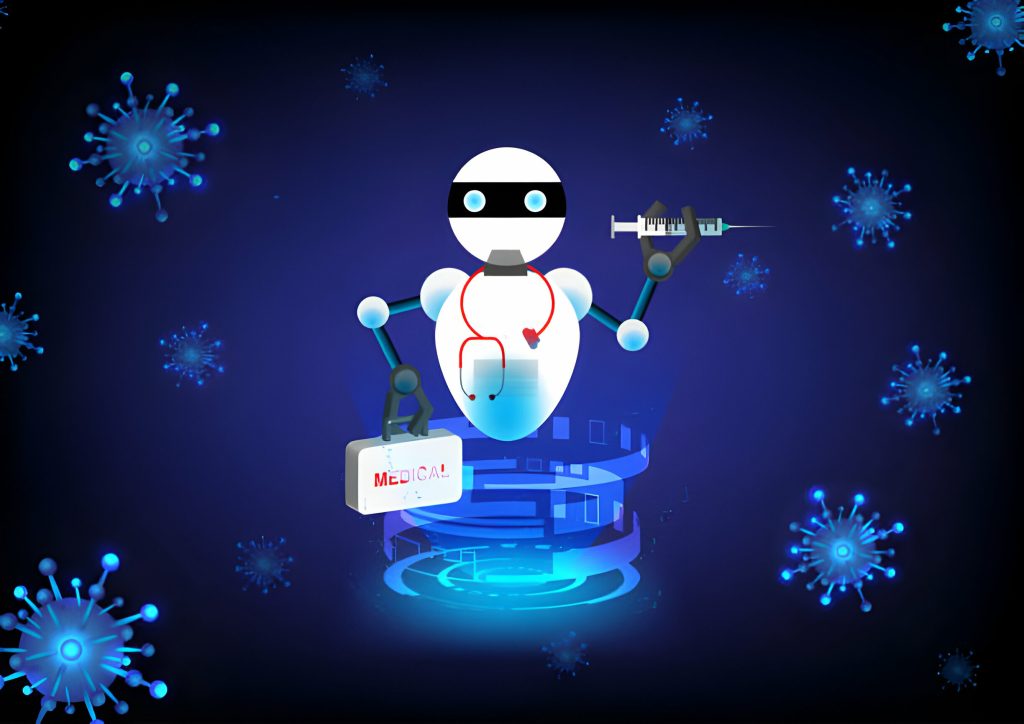It’s been making waves lately, revolutionizing diagnosis and treatment by crunching massive amounts of data. And when it comes to those pesky rare diseases with limited info available, AI swoops in like a superhero. We’re talking computer vision analyzing genetic variants and facial features, natural language processing extracting vital info from clinical notes – the works. Get ready to explore how AI is changing the game for rare disease diagnosis!
The Potential of AI in Diagnosing Rare Diseases
AI has the potential to greatly assist in diagnosing rare diseases by analyzing digital images, considering factors like family history and medical reports, and extracting crucial information from unstructured clinical notes using natural language processing (NLP). AI’s impact on rare disease diagnosis is significant, as it enables healthcare professionals to accurately identify and diagnose these conditions. Advancements in precision medicine through AI have enabled computer vision technologies that can analyze digital images for signs of rare diseases. NLP plays a vital role in extracting relevant information from clinical notes, allowing for a comprehensive understanding of a patient’s medical history. Additionally, AI-driven drug discovery for rare diseases holds promise in finding effective treatments. Overall, AI has revolutionized the field of rare disease diagnosis by leveraging advanced technologies like computer vision and NLP.
Challenges in Diagnosing Rare Diseases With AI
When it comes to identifying uncommon medical conditions, you may encounter difficulties due to limited data availability and the unique nature of these diseases. AI has shown great potential in diagnosing rare diseases, but there are still challenges that need to be addressed. One of the limitations of AI is the availability of data. Rare diseases often have a limited number of cases, making it difficult to gather sufficient data for analysis. Another challenge is genetic variant analysis. Rare diseases are often caused by specific genetic mutations, and accurately identifying these variants can be complex and time-consuming. Facial recognition for diagnosis is another area where AI faces limitations. While facial features can provide valuable clues for certain rare disorders, there are many factors that can affect facial appearance, making it challenging for AI algorithms to accurately diagnose based on this alone. Lastly, AI in drug discovery for rare diseases is still in its early stages. Developing effective treatments requires a deep understanding of the underlying biology and mechanisms, which can be challenging when dealing with rare conditions. Despite these limitations, advancements in AI continue to improve the diagnosis and treatment of rare diseases.
| Challenges | Solutions |
|---|---|
| Data availability | Collaborations with |
| challenges | research institutions |
| Sharing resources among | |
| healthcare providers | |
| Genetic variant | Advanced sequencing |
| analysis | techniques |
| Facial recognition | Integration with other |
| for diagnosis | diagnostic tools |
| Validation through | |
| clinical studies | |
| AI in drug | Increased collaboration |
| discovery | between researchers |
Using Computer Vision to Aid in Rare Disease Diagnosis
Computer vision technology assists in identifying and analyzing digital images to aid in the diagnosis of uncommon medical conditions. This technology has revolutionized the field of healthcare by providing AI-driven diagnosis and clinical decision support. Through advanced image analysis techniques and machine learning algorithms, computer vision applications can accurately identify rare diseases that may be challenging for human clinicians to diagnose.
Incorporating AI into the diagnostic process allows for more precise and efficient identification of these conditions. Here are three key points regarding the use of computer vision in aiding rare disease diagnosis:
- Computer vision applications utilize image analysis techniques to analyze digital images and extract relevant information.
- Machine learning algorithms enable computers to learn from vast datasets, improving their accuracy in diagnosing rare diseases.
- The integration of computer vision technology provides clinical decision support, helping healthcare professionals make informed decisions based on objective data.
Leveraging Family History and Genetic Reports for Diagnosis
To improve the accuracy of diagnosing uncommon medical conditions, you can leverage family history and genetic reports as valuable sources of information. Family history plays a crucial role in identifying potential genetic diseases that may run in your family. By understanding your family’s medical background, healthcare professionals can better assess your risk for certain conditions and tailor their diagnostic approach accordingly. Genetic reports provide additional insights into your unique genetic makeup, allowing for a more personalized medicine approach to diagnosis and treatment. Integrating data from both family history and genetic reports enhances diagnostic accuracy by providing a comprehensive picture of your health profile. This integration enables healthcare professionals to make more informed decisions about testing, monitoring, and treatment options specific to your condition, ultimately improving patient outcomes.
The Role of Natural Language Processing in Rare Disease Diagnosis
Natural language processing (NLP) plays a critical role in extracting relevant information from clinical notes for the diagnosis of uncommon medical conditions. With advancements in AI, NLP applications have become instrumental in rare disease screening and AI-driven diagnosis. Here’s how NLP is revolutionizing the analysis of clinical notes:
- Improved Diagnosis: NLP helps physicians screen patients for genetic conditions and diagnose rare diseases accurately.
- Extracting Crucial Information: By analyzing unstructured data like clinical notes, NLP can extract valuable insights that aid in diagnosing rare diseases.
- Enhancing Efficiency: With NLP, AI-driven diagnosis becomes more efficient by automating the analysis of large volumes of clinical text.
The integration of NLP advancements into healthcare has opened up new possibilities for diagnosing rare diseases, ensuring earlier detection and improved patient outcomes.
Emerging AI Applications for Rare Diseases
The development of AI applications offers promising solutions for the identification and treatment of uncommon medical conditions. AI has proven to be a valuable tool in various aspects of healthcare, including rare diseases. In recent years, there have been emerging AI applications specifically designed for rare diseases. For example, AI-powered drug discovery is being used to predict successful treatments for these conditions. AI is also being utilized in clinical trials to optimize traditional randomized control trials and reduce drug research costs. In addition, AI is playing a role in patient monitoring, personalized medicine, and rare disease research. These advancements in AI technology provide hope for improved diagnosis and treatment options for individuals with rare diseases.
Precision Medicine and AI in Rare Disease Diagnosis
You can benefit from the use of precision medicine and AI in diagnosing uncommon medical conditions. With advancements in genetic analysis and machine learning, these technologies enable clinical decision support and data integration to improve rare disease diagnosis. Here’s how they can help:
- Precision Medicine: Tailoring treatment plans based on an individual’s unique genetic makeup allows for more targeted therapies.
- Genetic Analysis: AI algorithms can analyze genomic data to identify rare genetic diseases and potential treatment options.
- Machine Learning: By learning from vast amounts of patient data, AI algorithms can recognize patterns and make accurate diagnoses.
The combination of precision medicine, genetic analysis, machine learning, clinical decision support, and data integration is revolutionizing the field of rare disease diagnosis. These technologies provide healthcare professionals with powerful tools to improve patient outcomes and reduce the time it takes to diagnose uncommon medical conditions.
The Development and Limitations of the SISH Algorithm
With its potential to efficiently retrieve images and diagnose various diseases, the SISH algorithm addresses limitations in pathology image retrieval. The algorithm, developed by investigators from the Mahmood Lab at Harvard Medical School and Brigham and Women’s Hospital, acts as a search engine for pathology images. While it has some limitations such as large memory requirements and limited context awareness within large tissue slides, SISH has proven to be proficient in diagnosing rare disease types and recognizing relevant regions of images for diagnosis. In the future, researchers hope to expand its capabilities to include multimodal case retrieval, enhancing pathology training, disease subtyping, tumor identification, and rare morphology identification. The development of the SISH algorithm was supported by organizations like the National Institute of General Medical Sciences, Brigham Presidents Fund, and Google Cloud Research Grant.
Future Directions and Applications of AI in Rare Disease Diagnosis
As image databases continue to grow, researchers hope that future advancements in AI will make disease identification easier. The integration of multiple data sources and improved genetic data analysis through AI advancements can have a significant impact on rare disease diagnosis. This can lead to improved patient outcomes and more data-driven treatment decisions. In order to achieve this, researchers are focusing on the following:
- Enhancing AI algorithms for better accuracy in diagnosing rare diseases.
- Developing methods to effectively analyze and interpret complex genetic data.
- Incorporating AI into clinical workflows to streamline the diagnostic process.
These advancements in AI have the potential to revolutionize rare disease diagnosis, providing faster and more accurate diagnoses, ultimately leading to improved patient care and outcomes.



